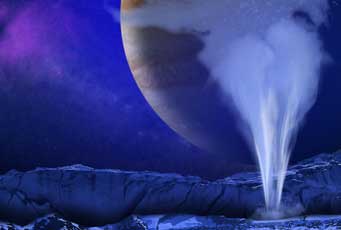A new look at old data suggests there’s something missing from suspected plumes on Europa: a heat source.

Usually we post articles about things astronomers find in the universe — new exoplanets, signals from black holes walloping into each other, and so forth. But this blog is about something planetary scientists didn’t find.
There’s a fair amount of evidence that Jupiter’s moon Europa has water plumes. Observations with the Hubble Space Telescope revealed emission from hydrogen and oxygen above part of the surface — and over that same region two years later. Reanalyzed data from the Galileo spacecraft, which visited the system in the 1990s, show the craft caught a taste of a plume, too. It’s all been rather on the edge of what these instruments can do, but given the moon’s subsurface ocean and its fractured surface, not to mention the little pockmarks called lenticulae (“freckles”) that might be cryovolcanoes, researchers expect plumes. And the water leaking out of Saturn’s much smaller moon Enceladus gives reason to hope.
The Europa studies tracked the putative plumes back to two locations near the moon’s equator. If the features were really spurts of water vapor being launched into space, then if they’re anything like similar geysers seen across the solar system (including on Earth), they need some sort of energy source. Such energy sources usually heat up the surface: We see these hotspots from everywhere to Yellowstone to the tiger stripe cracks at Enceladus’s south pole.
But Europa appears to have no hotspots.
We’d thought perhaps it did. The surface location that Hubble spotted vapors hovering over matched up with a small uptick in surface temperature seen by Galileo, a region just north of an impact crater named Pwyll and covered with a blanket of ejected debris. But the difference was only a few kelvins, and there were only good data for during local nighttime. Back when the data were first reported in 1999, the authors had doubted a subsurface heat source.
Earlier this year, Samantha Trumbo (Caltech) and others took another look at Europa’s surface, this time during the day in 2015 using ALMA. They found that the same location in daytime looked colder than its surroundings — a very unlikely behavior for a hotspot, especially if it was spewing out the water detected in 2016 Hubble data.
Julie Rathbun (Planetary Science Institute) and John Spencer (Southwest Research Institute) have now taken their own, global look at Europa, using the Galileo and ALMA data. They calculated how different parts of Europa’s surface might absorb and reemit sunlight’s warmth, looking particularly at the two surface locations over which plumes have appeared. The calculations confirm the Trumbo team’s conclusion: Hotspots don’t look like the right solution. Instead, we’re likely dealing with surfaces with different thermal inertias — surfaces that offer different levels of resistance to cooling or heating up.
“If you’re at the beach, the sand reacts differently to sunlight than a rock [does],” Rathbun explained during a press conference October 22nd at the annual meeting of the American Astronomical Society’s Division for Planetary Sciences. “The sand warms up very fast and cools off very quickly; the rock takes a while: nice and cool in the morning, and then it stays warm at night.” The same thing appears to be happening on Europa.
So if the plumes do exist — which they might not — what powers them? The answer could still be hotspots, if they’re small enough: Heat sources about the same size as the average lenticula and the same temperature of Enceladus’s tiger stripes would duck detection in current data. Lenticulae are certainly a good suspect, if they’re truly ice volcanoes. Or the plumes might be sporadic. Or perhaps there’s some unheard-of way to create geysers without a heat source.
For hope of an answer, Rathbun points to NASA’s upcoming Europa Clipper mission (of which she’s a member), which will launch in the 2020s to study the moon in more detail. The spacecraft’s thermal imager will produce images with resolution 100 times better than what we have now, she said, and would indubitably find hotspots if they exist.
A video of the press conference will be available shortly.
 0
0









Comments
You must be logged in to post a comment.